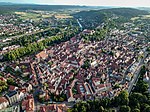Württemberg-Hohenzollern
1945 establishments in Germany1952 disestablishments in West GermanyFormer states and territories of Baden-WürttembergStates and territories disestablished in 1952States and territories established in 1945

Württemberg-Hohenzollern (French: Wurtemberg-Hohenzollern [vyʁtɑ̃bɛʁɡ‿ɔɑ̃zɔlɛʁn]) was a West German state created in 1945 as part of the French post-World War II occupation zone. Its capital was Tübingen. In 1952, it was merged into the newly founded state of Baden-Württemberg.
Excerpt from the Wikipedia article Württemberg-Hohenzollern (License: CC BY-SA 3.0, Authors, Images).Württemberg-Hohenzollern
Uhlandstraße,
Geographical coordinates (GPS) Address Phone number Website Nearby Places Show on map
Geographical coordinates (GPS)
| Latitude | Longitude |
|---|---|
| N 48.516666666667 ° | E 9.05 ° |
Address
Kepler-Gymnasium
Uhlandstraße 30
72072 , Universität
Baden-Württemberg, Germany
Open on Google Maps










